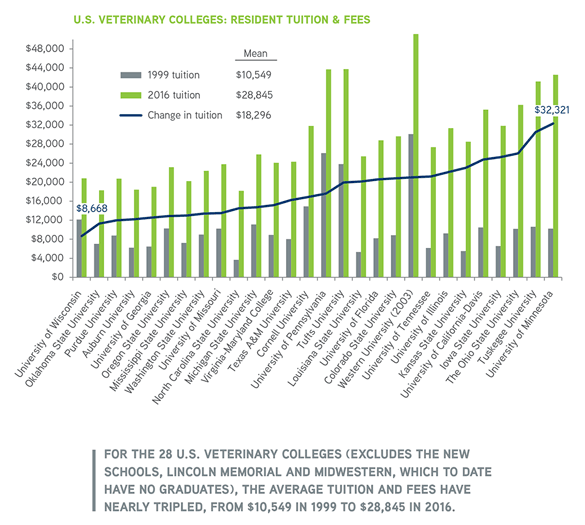Students limited in ability to control educational debt
Tuition at U.S. veterinary colleges has increased substantially over the past two decades, at some colleges by as much as 300 percent, according to the 2017 AVMA Report on Veterinary Markets.
The increase varies widely across institutions, however. At the University of Wisconsin, for example, in-state tuition went up 71 percent—approximately $8,000—over the 18-year period ending in 2016, while the University of Minnesota, by comparison, saw a 315 percent increase in tuition over the same period—an increase of more than $32,000.

“Budget cuts and reallocation of state resources often chip away at school funds’ appropriations, and so this cost is absorbed by students through increased tuition,” explained Bridgette Bain, PhD, assistant director for analytics in the AVMA Economics Division. She and the entire division work to monitor the costs of veterinary education as well as analyze how tuition changes across institutions affect the market for veterinary education and, in turn, the market for veterinarians.
One area of expense that Dr. Bain sees as having a less pronounced effect on the cost of obtaining a veterinary degree is the cost of living—a factor over which students appear to have more control (J Am Vet Med Assoc 2016;249:285-288).

“The cost of living across schools varies relatively minimally in comparison to the variability in respective tuition and fees at these schools,” she said. “Students are often resourceful, minimizing cost of living, and more frequently than not report living expenses that are below what the financial aid offices at these institutions recommend. Since students generally report frugality in their expenditures, we do not find substantial variability in the cost of living across various states at veterinary colleges.”
The entire report is available for free download by AVMA members at jav.ma/2017markets. The report series is available for purchase by nonmembers here.
Barbara Dutton is the economics writer/content coordinator for the AVMA Veterinary Economics Division.
Related JAVMA content:
Tool details, compares cost of veterinary education (Nov. 15, 2016)
Students press for personal finance education (June 15, 2016)